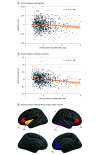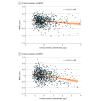Neurocognitive Analysis of Low-level Arsenic Exposure and Executive Function Mediated by Brain Anomalies Among Children, Adolescents, and Young Adults in India
- PMID: 37171822
- PMCID: PMC10182429
- DOI: 10.1001/jamanetworkopen.2023.12810
Neurocognitive Analysis of Low-level Arsenic Exposure and Executive Function Mediated by Brain Anomalies Among Children, Adolescents, and Young Adults in India
Erratum in
-
Error in an Affiliation and Corresponding Author Address.JAMA Netw Open. 2023 Jun 1;6(6):e2321313. doi: 10.1001/jamanetworkopen.2023.21313. JAMA Netw Open. 2023. PMID: 37310744 Free PMC article. No abstract available.
Abstract
Importance: Arsenic, a contaminant of groundwater and irrigated crops, is a global public health hazard. Exposure to low levels of arsenic through food extends well beyond the areas with high arsenic content in water.
Objective: To identify cognitive impairments following commonly prevalent low-level arsenic exposure and characterize their underlying brain mechanisms.
Design, setting, and participants: This multicenter population-based cohort study analyzed cross-sectional data of the Indian Consortium on Vulnerability to Externalizing Disorders and Addictions (cVEDA) cohort, recruited between November 4, 2016, and May 4, 2019. Participants aged 6 to 23 years were characterized using deep phenotyping measures of behavior, neuropsychology, psychopathology, brain neuroimaging, and exposure to developmental adversities and environmental neurotoxins. All analyses were performed between June 1, 2020, and December 31, 2021.
Exposure: Arsenic levels were measured in urine as an index of exposure.
Main outcomes and measures: Executive function measured using the cVEDA neuropsychological battery, gray matter volume (GMV) from T1-weighted magnetic resonance imaging, and functional network connectivity measures from resting state functional magnetic resonance imaging.
Results: A total of 1014 participants aged 6 to 23 years (589 male [58.1%]; mean [SD] age, 14.86 [4.79] years) were included from 5 geographic locations. Sparse-partial least squares analysis was used to describe a negative association of arsenic exposure with executive function (r = -0.12 [P = 5.4 × 10-4]), brain structure (r = -0.20 [P = 1.8 × 10-8]), and functional connectivity (within network, r = -0.12 [P = 7.5 × 10-4]; between network, r = -0.23 [P = 1.8 × 10-10]). Alterations in executive function were partially mediated by GMV (b = -0.004 [95% CI, -0.007 to -0.002]) and within-network functional connectivity (b = -0.004 [95% CI, -0.008 to -0.002]). Socioeconomic status and body mass index moderated the association between arsenic and GMV, such that the association was strongest in participants with lower socioeconomic status and body mass index.
Conclusions and relevance: The findings of this cross-sectional study suggest that low-level arsenic exposure was associated with alterations in executive functioning and underlying brain correlates. These results indicate potential detrimental consequences of arsenic exposure that are below the currently recommended guidelines and may extend beyond endemic risk areas. Precision medicine approaches to study global mental health vulnerabilities highlight widespread but potentially modifiable risk factors and a mechanistic understanding of the impact of low-level arsenic exposure on brain development.
Conflict of interest statement
Figures



References
-
- United Nations Children’s Fund (UNICEF) . Guidance on the investigation & mitigation of arsenic contamination. 2018. Accessed November 23, 2020. https://www.unicef.org/media/91296/file/UNICEF-WHO-Arsenic-Primer.pdf
-
- World Health Organization . Arsenic. December 7, 2022. Accessed March 12, 2023. https://www.who.int/news-room/fact-sheets/detail/arsenic
-
- Mori S, Lowenstein EJ, Steffen C. The largest mass poisoning in history: arsenic contamination of well water in Bangladesh. Skinmed. 2018;16(4):265-267. - PubMed
-
- Schneider P, Asch F. Rice production and food security in Asian Mega deltas—a review on characteristics, vulnerabilities and agricultural adaptation options to cope with climate change. J Agron Crop Sci. 2020;206(4, special issue):491-503. doi:10.1111/jac.12415 - DOI
Publication types
MeSH terms
Substances
Grants and funding
LinkOut - more resources
Full Text Sources
Medical

